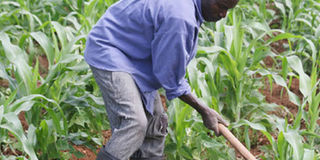With proper planning, farmers can thrive in a world of shifting climates

Dominic Sanganyi, a small scale farmer at Kiplombe in Eldoret weeds his maize crop. Rural communities focused on small-scale farming the traditional way have to contend with diminishing land that may not provide gainful employment to the burgeoning youth numbers or feed families, let alone produce surpluses for the market. FILE PHOTO | JARED NYATAYA |
What you need to know:
- This is our chance to start developing a more definitive climate change adaptation plan for Kenyan agriculture.
- Depending on how climate change plays out, the range of outcomes could be significant. Maize output could rise by 60 per cent, or even as much as 100 per cent. The number of malnourished children could fall by as much as 90 per cent, or as little as 30 per cent.
Almost everyone who lives in Kenya is a farmer, depending on the rain to coax food from the earth. But millions of Kenyan farmers will tell you that something in the skies is changing.
In some areas of the country, excessive rains have caused ruinous landslides. In others, the rains are either too little or too late and crops wither in the fields. But for everyone, the result is the same: more poverty and more hunger.
Concern is growing in Kenya that these extremes are just the beginning of the consequences of climate change. In fact, there is considerable evidence that right now, and for the foreseeable future, the build-up of greenhouse gases in the upper atmosphere will progressively alter conditions for cultivating life-sustaining food crops.
Government leaders have seen the signs and responded accordingly. In 2012, they developed the Kenya Climate Change Action Plan. What is still missing, however, is a detailed strategy for keeping food production vibrant as climate change cranks up across the country.
This week, policymakers are convening in Naivasha for the National Adaptation Planning (NAP) conference organised by Kenya’s Agriculture and Environment ministries and the CGIAR Research Programme on Climate Change, Agriculture and Food Security (CCAFS).
This is our chance to start developing a more definitive climate change adaptation plan for Kenyan agriculture.
Scientists have developed four different scenarios, or “climate models,” each revealing different outcomes for food production between now and 2050. One shows areas of the Rift Valley and coastal provinces becoming too hot or too dry to support maize cultivation. Another model indicates maize yields could increase in all areas where it is currently grown.
What is really interesting is that all the models show that farmers will likely be able to grow maize in a few parts of Kenya that in the past have been too dry or too cool to support the crop. They also indicate that in the near future, wheat yields will fall in fields cultivated on the slopes of Mounts Kenya and Elgon, but increase in areas near Nakuru.
The researchers predict that based on the current rate of technological progress in farm production, the overall trend over the next few decades should be one of rising food output and decreasing malnutrition in Kenya.
Depending on how climate change plays out, the range of outcomes could be significant. Maize output could rise by 60 per cent, or even as much as 100 per cent. The number of malnourished children could fall by as much as 90 per cent, or as little as 30 per cent.
BETTER PREPARED
The key message for our decision makers is that while there is still uncertainty in the forecast, a picture is starting to emerge for Kenya’s future farming conditions and policies can be put in place now that will leave us better prepared for any of these scenarios.
We can be ready to take advantage of better growing conditions for maize or, conversely, to help farmers switch to other types of food crops if the climate becomes less maize-friendly.
We can also develop maize varieties that are resilient to heat and drought, and others with higher yield-potential if conditions improve.
We can examine the regions that might become more conducive to maize production and consider whether, due to environmental concerns, we should protect some areas and selectively develop others.
And we can invest in the research that can generate innovations, like drought- or heat-tolerant crop varieties, and in the agricultural advisory services critical to ensuring farmers are able to make use of them.
As global talks aimed at slowing the pace of climate change appear to be deadlocked, it is time for Kenyans to become the masters of their own fate and take advantage of the opportunity to develop a comprehensive climate change adaptation plan for agriculture.
This plan must be based on a sound vision for climate smart agriculture, be responsive to Kenya Vision 2030 and put the country on a low carbon growth across agriculture and other sectors.
Dr James Kinyangi is the regional programme leader for CCAFS East Africa; Timothy Thomas a senior researcher at the International Food and Policy Institute (Ifpri); while Dr Michael Waithaka is the manager for policy analysis and advocacy programme of the Association for Strengthening Agricultural Research in Eastern and Central Africa (Asareca).




